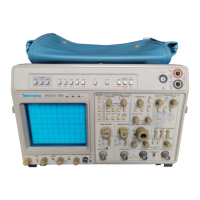General Information
Preparation for Use
Safety
Before connecting the oscilloscope to a power source, read entirely both this
section and the Safety Summary at the front of this
manual. Be sure you have the
training required
to
safely connect the instrument inputs to the signals you will
be
measuring. Refer to the Safety Summary for power source, grounding, and other
safety considerations pertaining to the use of the instrument.
This
instrument may be damaged
if
operated with
the
LINE VOLTAGE
SELECTOR switch set for
the
wrong applied ac input-source voltage or
if
the
wrong
line
fuse
is
installed.
Line Voltage Selection
The oscilloscope operates from either a 115-V or a 230-V nominal ac power-line
with any frequency from 48 Hz to 440 Hz. Before connecting the power cord to a
power source, verify that the LINE
VOLTAGE SELECTOR switch, located on the
rear
panel
(see
Figure 1-1),
is
set correctly (see Table 1-1) and that the line fuse
is
correct. To convert the instrument for operation on the other line-voltage range,
move the LINE
VOLTAGE SELECTOR switch
to
the correct nominal ac source-
voltage setting. The detachable power cord may have to
be
replaced
to
match the
particular power source.
Line Fuse
To verify the instrument power-input fuse rating, do the following steps:
1.
Press the fuse-holder cap and release it with a slight counterclockwise
rotation.
Pull
the cap (with the attached fuse inside) out of the fuse holder.
2.
Verify that the fuse is of the type listed on the back of the instrument.
Then
install the proper fuse and reinstall the proper fuse-holder cap. The
two types of fuses
listed are not directly interchangeable; they require
different types of fuse caps.
Included
in
the accessory pouch
is
a 5x20
mm
fuse holder cap for use with 1.6
A,
250
V,
5x20
mm
(IEC 127) fuses.
2465A/2455A/2445A Operators
1-1

